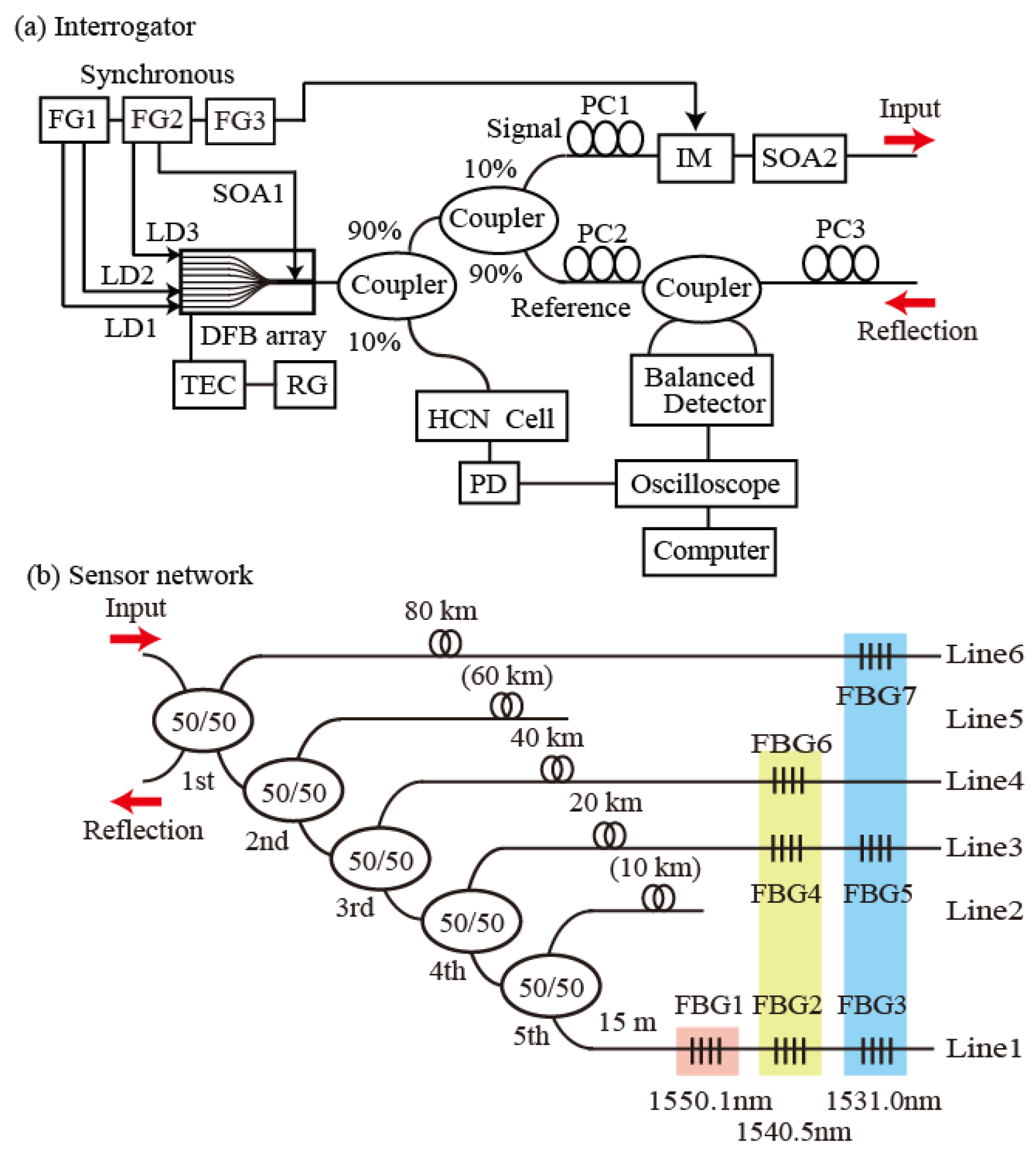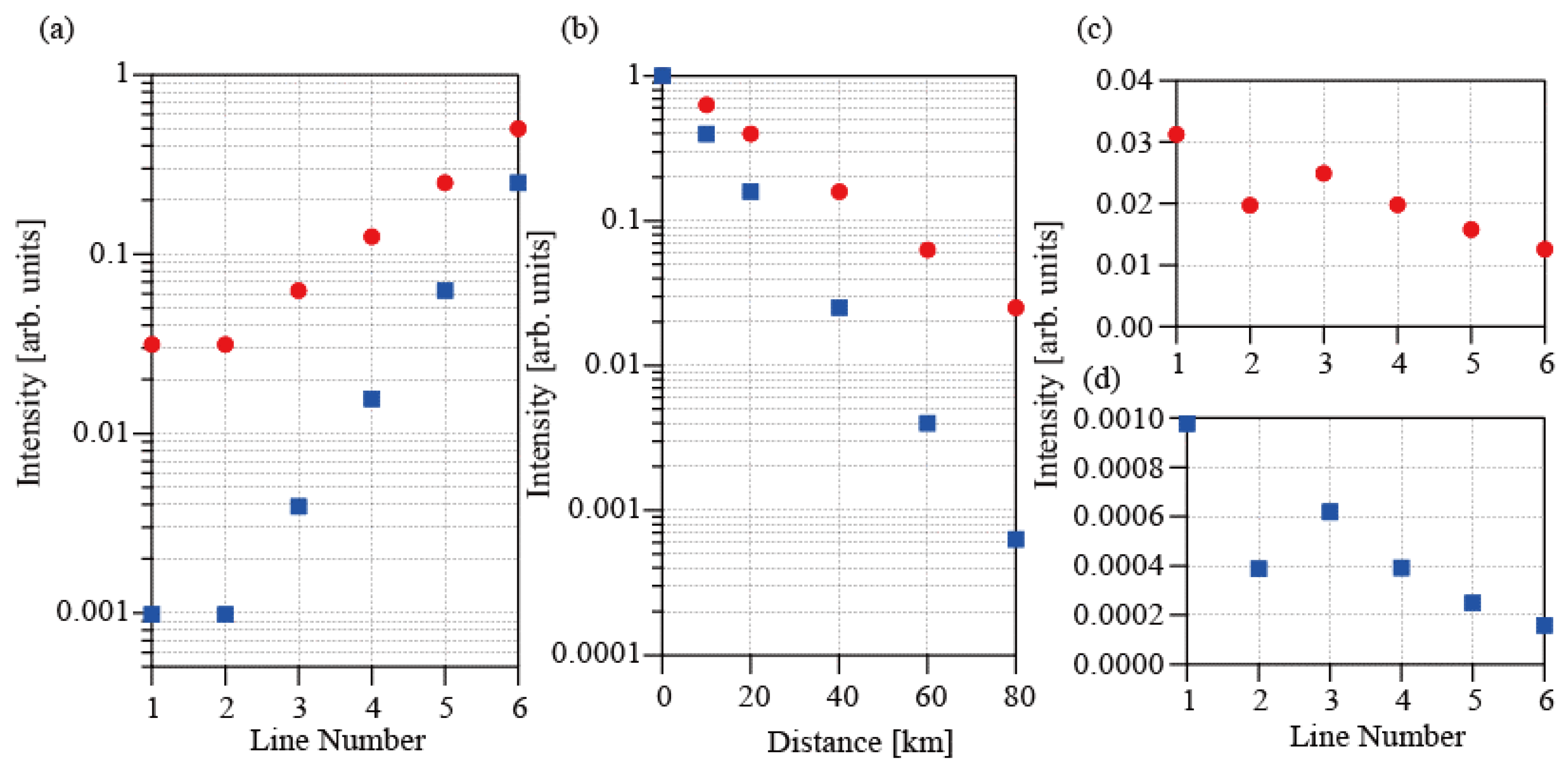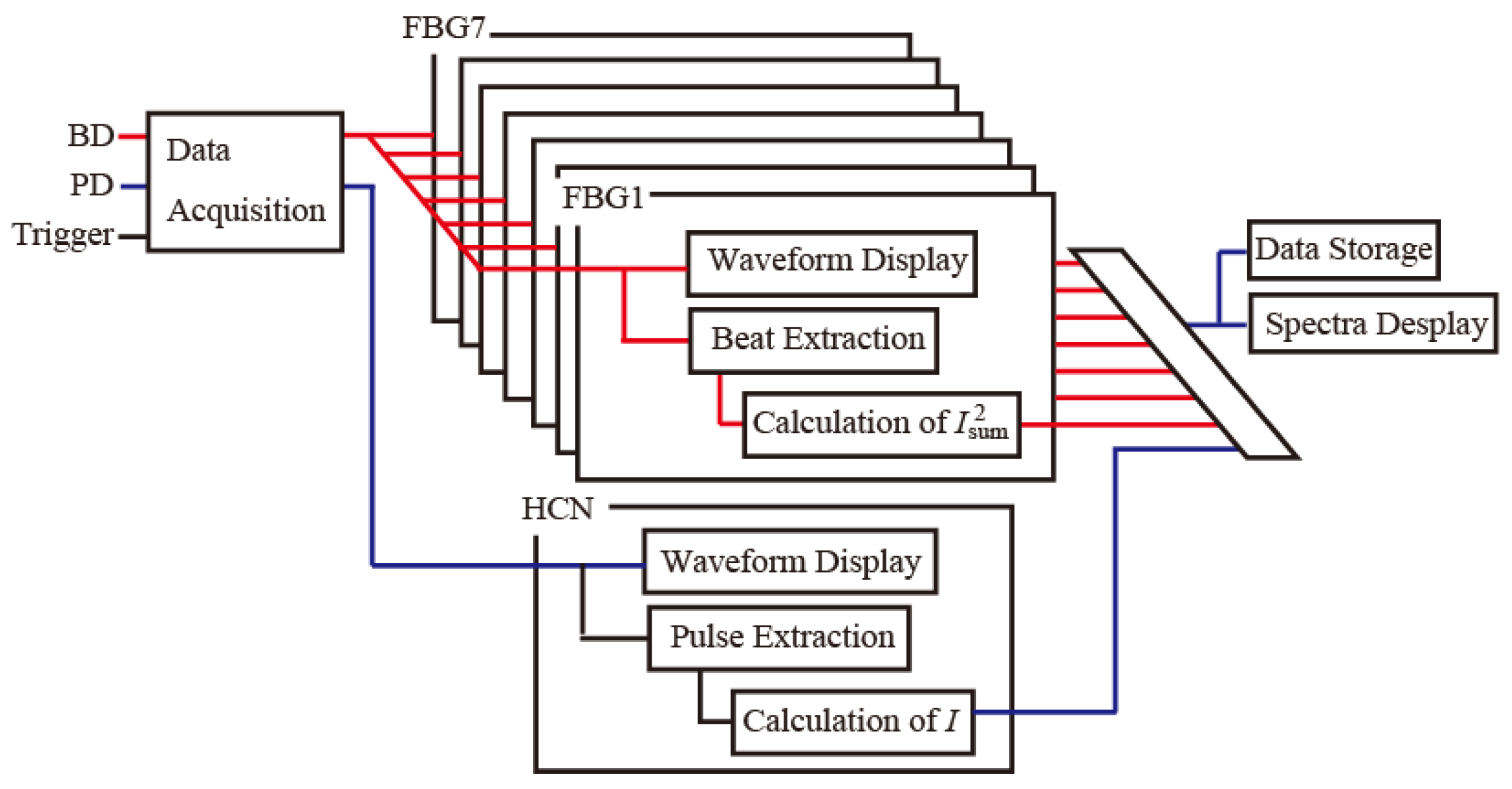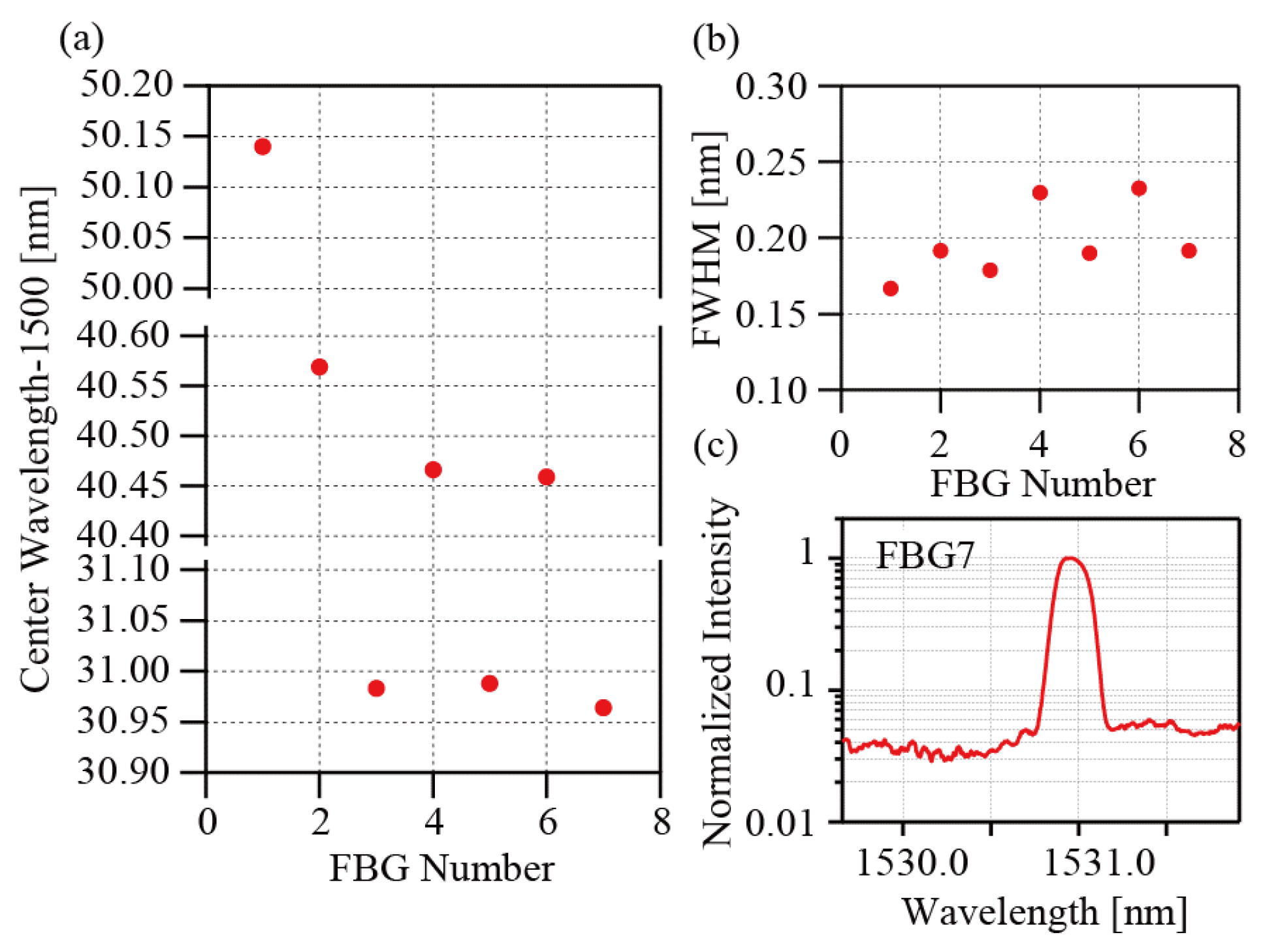Long-Distance FBG Sensor Networks Multiplexed in Asymmetric Tree Topology
Abstract
1. Introduction
2. Heterodyne Detection
3. Experimental Section
3.1. Interrogator
3.2. Sensor Network
3.3. Dependences of the Reflection Intensities
3.4. Time Charts for the Applied Voltages
4. Results
5. Conclusions
Funding
Institutional Review Board Statement
Informed Consent Statement
Data Availability Statement
Acknowledgments
Conflicts of Interest
Abbreviations
| DFB-LD | Distributed feedback laser |
| FBG | Fiber Bragg grating |
| TDM | Time-division multiplexing |
| WDM | Wavelength-division multiplexing |
| HD | Heterodyne detection |
| ID | Intensity detection |
| BD | Balanced detector |
| SOA | Semiconductor optical amplifier |
| PD | Photodetector |
| IM | Intensity modulator |
| FG | Function generator |
| PC | Polarization controller |
| FWHM | full width at half maximum |
| SNR | signal-to-noise ratio |
References
- Gui, X.; Li, Z.; Fu, X.; Guo, H.; Wang, Y.; Wang, C.; Wang, J.; Jiang, D. Distributed Optical Fiber Sensing and Applications Based on Large-Scale Fiber Bragg Grating Array: Review. J. Lightw. Technol. 2023, 41, 4187–4200. [Google Scholar] [CrossRef]
- Pendão, C.; Silva, I. Optical Fiber Sensors and Sensing Networks: Overview of the Main Principles and Applications. Sensors 2022, 22, 7554. [Google Scholar] [CrossRef]
- Min, R.; Liu, Z.; Pereira, L.; Yang, C.; Sui, Q.; Marques, C. Optical fiber sensing for marine environment and marine structural health monitoring: A review. Opt. Laser Technol. 2021, 140, 107082. [Google Scholar] [CrossRef]
- Wang, Y.; Gong, J.; Wang, D.Y.; Dong, B.; Bi, W.; Wang, A. A Quasi-Distributed Sensing Network with Time-Division-Multiplexed Fiber Bragg Gratings. IEEE Photon. Technol. Lett. 2011, 23, 70–72. [Google Scholar] [CrossRef]
- Zhang, M.; Sun, Q.; Wang, Z.; Li, X.; Liu, H.; Liu, D. A large capacity sensing network with identical weak fiber Bragg gratings multiplexing. Opt. Commun. 2012, 285, 3082–3087. [Google Scholar] [CrossRef]
- Margulis, W.; Lindberg, R.; Laurell, F.; Hedin, G. Intracavity interrogation of an array of fiber Bragg gratings. Opt. Expr. 2021, 29, 111–118. [Google Scholar] [CrossRef]
- Yuan, L.; Wang, Q.; Zhao, Y. A passive ladder-shaped sensor architecture with failure detection based on fiber Bragg grating. Opt. Fiber Technol. 2023, 81, 103540. [Google Scholar] [CrossRef]
- Luo, Z.; Wen, H.; Guo, H.; Yang, M. A time- and wavelength-division multiplexing sensor network with ultra-weak fiber Bragg gratings. Opt. Exp. 2013, 21, 22799–22807. [Google Scholar] [CrossRef]
- Yuan, L.; Wang, Q.; Zhao, Y. A wavelength-time division multiplexing sensor network with failure detection using fiber Bragg grating. Opt. Fiber Technol. 2024, 88, 103818. [Google Scholar] [CrossRef]
- Perez-Herrera, R.A.; Lopez-Amo, M. Fiber optic sensor networks. Opt. Fiber Technol. 2013, 19, 689–699. [Google Scholar] [CrossRef]
- Lee, J.H.; Kim, J.; Han, Y.G.; Kim, S.H.; Lee, S.B. Investigation of Raman fiber laser temperature probe based on fiber Bragg gratings for long-distance remote sensing applications. Opt. Expr. 2004, 12, 1747–1752. [Google Scholar] [CrossRef] [PubMed]
- Hu, J.; Chen, Z.; Yang, X.; Ng, J.; Yu, C. 100-km Long Distance Fiber Bragg Grating Sensor System Based on Erbium-Doped Fiber and Raman Amplification. IEEE Photon. Technol. Lett. 2010, 22, 1422–1424. [Google Scholar] [CrossRef]
- Huh, J.H.; Chang, Y.M.; Yan, L.; Lee, J.H. Performance comparison of Raman/erbium-doped-fiber hybrid-amplification-based long-distance fiber Bragg grating sensor systems. Appl. Opt. 2012, 51, 348–355. [Google Scholar] [CrossRef] [PubMed]
- Peng, P.C.; Feng, K.M.; Peng, W.R.; Chiou, H.Y.; Chang, C.C.; Chi, S. Long-distance fiber grating sensor system using a fiber ring laser with EDWA and SOA. Opt. Commun. 2005, 252, 127–131. [Google Scholar] [CrossRef]
- Han, Y.G.; Tran, T.V.A.; Kim, S.H.; Bae Lee, S.B. Multiwavelength Raman-fiber-laser-based long-distance remote sensor for simultaneous measurement of strain and temperature. Opt. Lett. 2005, 30, 1282–1284. [Google Scholar] [CrossRef]
- Hu, J.; Chen, Z.; Yu, C. 150-km Long Distance FBG Temperature and Vibration Sensor System Based on Stimulated Raman Amplification. J. Lightw. Technol. 2012, 30, 1237–1243. [Google Scholar] [CrossRef]
- Diaz, S.; Lasheras, G.; Lopez-Amo, M. WDM bi-directional transmission over 35 km amplified fiber-optic bus network using Raman amplification for optical sensors. Opt. Expr. 2005, 13, 9666–9671. [Google Scholar] [CrossRef]
- Diaz, S.; Beatriz, C.; Lasheras, G.; Lopez-Amo, M. Double Raman Amplified Bus Networks for Wavelength-Division Multiplexing of Fiber-Optic Sensors. J. Lightw. Technol. 2007, 25, 733–739. [Google Scholar] [CrossRef]
- Fernandez-Vallejo, M.; Lopez-Amo, M. Optical Fiber Networks for Fiber Optic Sensors. Sensors 2012, 12, 3929–3951. [Google Scholar] [CrossRef]
- Rao, Y.J.; Lobo Ribeiro, A.B.; Jackson, D.A.; Zhang, L.; Bennion, I. Combined spatial- and time-division-multiplexing scheme for fiber grating sensors with drift-compensated phase-sensitive detection. Opt. Lett. 1995, 20, 2149–2151. [Google Scholar] [CrossRef]
- Talaverano, L.; Abad, S.; Jarabo, S.; Lopez-Amo, M. Multiwavelength fiber laser sources with Bragg-grating sensor multiplexing capability. J. Lightw. Technol. 2001, 19, 553–558. [Google Scholar] [CrossRef]
- Kuroda, K. Heterodyne detection applied to a fiber Bragg grating-based sensor using a directly modulated distributed feedback laser. Opt. Lett. 2021, 46, 3985–3988. [Google Scholar] [CrossRef] [PubMed]
- Kuroda, K. Long-Distance Quasi-Distributed FBG Sensor System Based on Time-Division Multiplexing. IEEE Photon. Technol. Lett. 2024, 36, 1133–1136. [Google Scholar] [CrossRef]
- Kuroda, K.; Oka, T. Interrogation of fiber Bragg grating-based sensors temporally and spectrally multiplexed in tree topology. J. Lightw. Technol. 2025, 43, 3786–3791. [Google Scholar] [CrossRef]
- Kuroda, K. Performance evaluation of a time-division multiplexed fiber Bragg grating sensor based on heterodyne detection. Appl. Opt. 2023, 62, 2869–2873. [Google Scholar] [CrossRef]
- Gilbert, S.L.; Swann, W.C.; Wang, C.M. Hydrogen Cyanide H13C14N Absorption Reference for 1530 nm to 1565 nm Wavelength Calibration-SRM 2519a; NIST Special Publication: Gaithersburg, MD, USA, 2005; p. 137. [Google Scholar]







Disclaimer/Publisher’s Note: The statements, opinions and data contained in all publications are solely those of the individual author(s) and contributor(s) and not of MDPI and/or the editor(s). MDPI and/or the editor(s) disclaim responsibility for any injury to people or property resulting from any ideas, methods, instructions or products referred to in the content. |
© 2025 by the author. Licensee MDPI, Basel, Switzerland. This article is an open access article distributed under the terms and conditions of the Creative Commons Attribution (CC BY) license (https://creativecommons.org/licenses/by/4.0/).
Share and Cite
Kuroda, K. Long-Distance FBG Sensor Networks Multiplexed in Asymmetric Tree Topology. Sensors 2025, 25, 4158. https://doi.org/10.3390/s25134158
Kuroda K. Long-Distance FBG Sensor Networks Multiplexed in Asymmetric Tree Topology. Sensors. 2025; 25(13):4158. https://doi.org/10.3390/s25134158
Chicago/Turabian StyleKuroda, Keiji. 2025. "Long-Distance FBG Sensor Networks Multiplexed in Asymmetric Tree Topology" Sensors 25, no. 13: 4158. https://doi.org/10.3390/s25134158
APA StyleKuroda, K. (2025). Long-Distance FBG Sensor Networks Multiplexed in Asymmetric Tree Topology. Sensors, 25(13), 4158. https://doi.org/10.3390/s25134158




